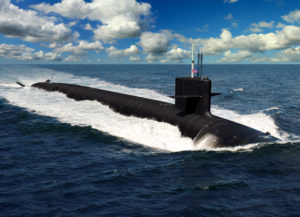The latest issue of the annual Government Accountability Office (GAO) assessment of major defense acquisition programs outlined remaining risks to the design and on-time production of the Columbia-class ballistic missile submarine (SSBN).
In the GAO’s Defense Acquisition Annual Assessment, published June 3, the office noted while the Navy reports the nuclear reactor technology as mature since 2018, “several other technologies we previously identified as critical remain immature.”

GAO explained manufacturing challenges delayed delivery of the first production-representative motor for the integrated power system by two years to 2019.
“The Navy still plans to concurrently test the motor, update its design, and build the lead submarine’s motor, then deliver the integrated power system to the shipyard in October 2022 as scheduled despite the compressed timeframe created by this delay,” the report said.
The Navy also does not expect the propulsor and shafting to reach maturity until the lead vessel is delivered in fiscal year 2026 because the Navy does not plan to test all components together in their final form and function before delivery.
However, “if deficiencies in these immature technologies emerge during testing, they could cause costly and time-intensive design changes and re-work, jeopardizing the lead submarine’s first patrol date,” GAO warned.
The report welcomed that as of September 2019, shipbuilder General Dynamics [GD] Electric Boat completed 100 percent of the basic and functional design of the submarine. However, GAO still said “risks to design stability remain.”
Notably, it said design stability is based on assumptions about the final form, fit, and function of critical technologies and how they will perform in a realistic environment. However, the program has not demonstrated that yet.
GAO argued a key tenet of the program’s cost and schedule goals assumes GD will finish 83 percent of detail design by October 2020.
“Over the past year, the shipbuilder missed its monthly detail design goals due to inefficient design software. Program officials report the shipbuilder increased its design staff in an effort to recover its schedule. However, delayed detail designs are impacting material orders, slowing construction progress, and jeopardizing the design completion goal,” the report said.
The report said the Navy is also still assessing the cost and schedule impacts of fixing weld defects in missile tubes for the common missile compartment. This is causing the shipbuilder to produce a replacement missile tube section for the lead submarine.
GAO said the weld issue underscored how “supplier quality and capacity continue to pose a risk to the lead submarine’s delivery schedule.”
In 2018, GD’s missile tube subcontractor BWX Technologies [BWXT] improperly welded a dozen common missile tubes for the Columbia-class submarines. Once it was forced to correct the issue costing $30 million, BWXT’s work on the tubes is no longer profitable.
Last August, BWXT said it was about halfway through repairing the tubes and it had received no new orders for tubes so it would leave the missile tube business if future contracts did not include favorable terms to remain profitable (Defense Daily, Aug. 6, 2019).
However, due to the COVID-19 pandemic affecting welders, delivery of missile tubes may be a few months late, Columbia Program Executive Officer Rear Adm. Scott Pappano said this week (Defense Daily, June 1).
GAO said after the weld issue was discovered, the Navy and GD reviewed supplier quality assurance practices and “found weld quality problems throughout the industrial base due to increased demand from shipbuilding programs and a reduction in independent supplier oversight.”
In response, GAO said the Navy is increasing oversight of high-risk suppliers and investing in improving quality.
The Navy also moved up plans to finalize negotiations and award GD a contract option for the first two submarines from October to May 2020. It expects to exercise this option in early FY 2021.
The report included Columbia-class program office comments that the Navy recognizes the supplier base is still at “high risk and is committed to increased oversight on manufacturing issues and readiness assessments.”
The Navy has repeatedly said the Columbia-class submarine is its top acquisition priority and if needed it could shift acquisition funds to maintain its schedule.
However, in 2019 the program manager said the Navy’s schedule has little margin for the vessel since it has already extended the service life of the existing Ohio-class SSBNs to 42 years.